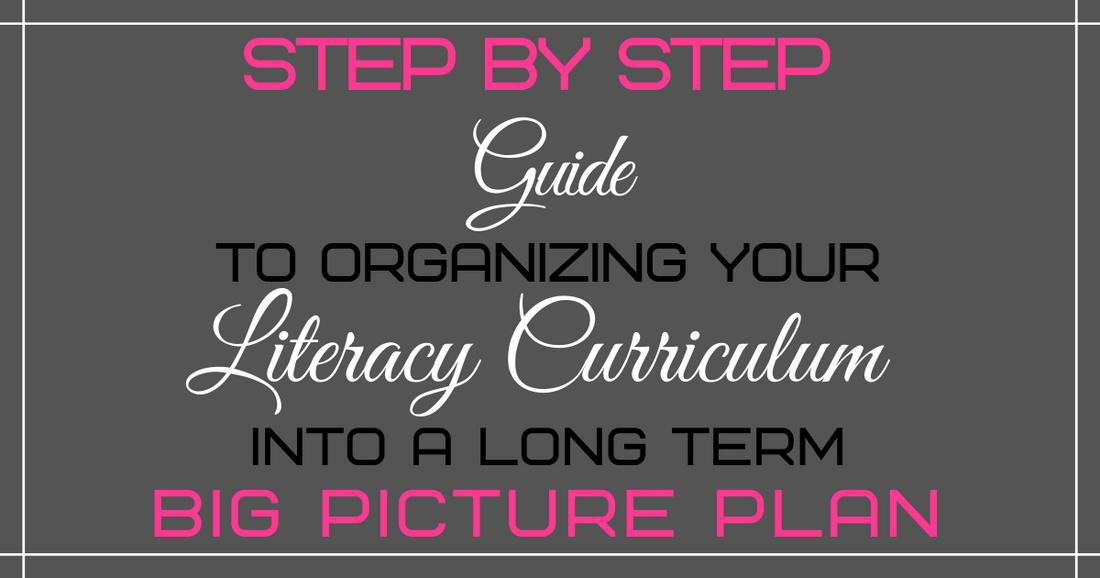Create an Outline
I am a very visual person and need to see the whole big picture. Isn't that teaching with the end in mind? I started by drawing a chart and hanging it inside the cabinet door in my classroom.
We were self-contained so the chart mapped out every subject area. If you are teaming, then just put together a template of your subjects taught.

However, it is important for Literacy and Social Studies teachers to know what their Math/Science teaching partners are doing. You should be able to support each other.
My fourth-grade teaching team would open my cabinet door and look at the year plan chart every time we planned. We would draw arrows to signify movement, add things in, take things out, etc. It was revised throughout the school year based on learner needs.
Over time it evolved into a spreadsheet that we could lay out in the middle of our planning table.
Each summer we would stare at the blank template…so overwhelming…but start putting in pieces a little at a time.
- Put in the calendar dates for each week in the school year in the first column
- Put in school holidays and professional development days.
- Now, I don’t even want to think about this, but write in the state testing administration dates.
This will give a sense of what the year will look like and where the breaks will fall within the planned instruction. This is looking at your year in teaching. Know that it’s probably going to change with new school district requirements and the unique needs of your students but that is what teaching is all about. Go with the flow and draw arrows and mark things out!
When you have the big picture set out in front of you it provides a focus for your school year and will keep you on track.
Now this outline is not about the specifics! It's about setting up the big ideas for the year and looking at how to spiral the standards and skills.
Line Up Read Alouds
Start with favorite read alouds. However, be cognizant of what students will like and enjoy. Fill those in throughout the year. I always try to put a few read alouds in the beginning of the year because the rest of the year will probably be filled in by student requests, new releases and classroom needs. However, if you have a favorite that you want to share with students but it might not be appropriate for the beginning of the year, place it where you would like to share it to hold that place and not forget about it.
Shared or Close Reading Experiences
Shared Reading texts should be short texts that can be revisited each day over a few days, typically a week. Shared Reading is a place where you can expose students to different genres, structures and complex texts. Be cognizant NOT to use shared reading within one subject area all year long. Spiral genres and text structures throughout the year. Decide on your Shared Reading rotation and place that on your chart. If you have titles of texts, then start putting those in over the course of the year.
Reading & Writing Workshop
This is where my team and I always slowed down our thinking while planning. We had many passionate discussions about what we should focus on and where it should occur throughout the year. These discussions were always based on the professional reading we had done over the summer and the knowledge we had about readers and writers at our grade level.
We always started with Launching Readers' & Writers' Workshop. Then we would center our units of study around the proficient reader strategies throughout the rest of the school year.
Word Work
Don’t forget to set up and launch word study in your classroom. It’s important to set up guidelines for the notebook or vessel in which word study activities will be housed.
Also, plan out a sequence of word features and word parts that you know you will have to start with because it has been a common trend over the past several years.
You know in your grade level those high frequency words that students come to you NOT knowing how to spell. Place those in the word study/word wall section of your chart.
Social Studies
Social Studies is another area where literacy instruction can flourish. Whether your district stays with traditional Social Studies instruction or you implement an Inquiry Workshop, this part of your instructional day provides great opportunities to use literacy strategies while learning content.
- First, think about the content for which your grade level is responsible. Then, think about the sequence of the content throughout the year.
- Next, lay out broad, general topics on the year planner you created.
- Decide about how long you should spend on each topic throughout the year.
Ready, Set, Go!
You now have a starting point and an outline!
This plan is not intended to be complete and comprehensive, but a beginning outline to keep you and your students on track.
As you find new information, strategies and activities for teaching different topics and concepts add those to your plan.
Your curriculum calendar will keep you focused and on track throughout the school year eliminating that feeling of just "spinning your wheels"!






